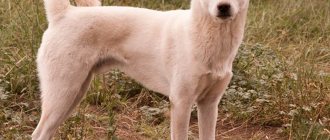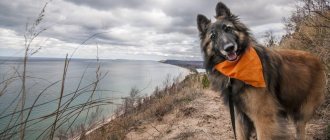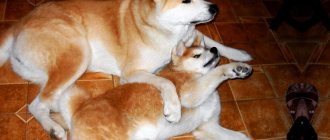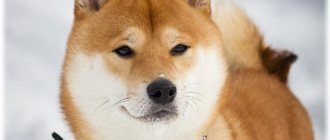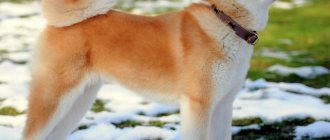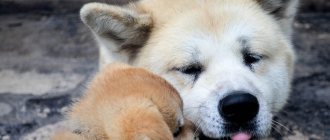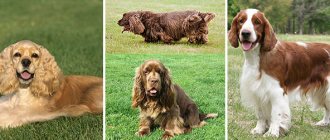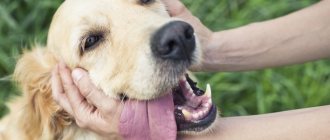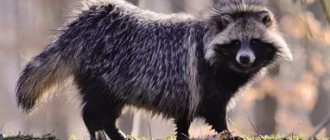Kai is a fairly unknown breed of dog. It should be noted that these Japanese dogs are rarely found outside their homeland. It is possible to note a number of similar characteristics with the Akita Inu, however, these animals are completely different.
Kai, or as it is also called a brindle dog, is a Spitz, and this can explain the slight growth of the animal. Regardless of its small size, the dog is very proud and stately. However, these qualities often interfere with the process of raising a pet.
At the same time, representatives of the breed are hunting dogs, which are characterized by agility, endurance, and high communication skills.
Maintenance and care
An intelligent brindle dog, the Kai is able to adapt to any climate.
In addition, this dog can be kept both in rural areas and in the city. Naturally, it is best for the animal to live in a private house, where there is a large garden plot, forest, and clearings in the area. Although, even in city conditions, representatives of the breed will not feel bad if the owner provides his animal with regular exercise. It is necessary to pay special attention to the fact that individuals of the breed need not only physical, but also intellectual exercise. Caring for such a pet is quite simple
You can only comb it a couple of times a week. You should wash your dog only when the need arises. Particular attention should be paid to the cleanliness of the dog’s ears and eyes. Every month you should trim your dog’s claws, unless, of course, they are worn off during walks.
Caring for such a pet is quite simple. You can only comb it a couple of times a week. You should wash your dog only when necessary.
Particular attention should be paid to the cleanliness of the dog’s ears and eyes. Every month you should trim your dog’s claws, unless, of course, they are worn off during walks.
Temperament
The Tora dog is freedom-loving and independent, it is fearless, active, dexterous, and fast. Representatives of the breed do not trust anyone at all, with the exception of their owner, to whom they are infinitely devoted and faithful.
Representatives of the breed have a certain resemblance to wolves; in the family circle these pets are gentle and affectionate, but outside the home they are extremely cautious, in some cases they show violent aggression, especially when they sense that someone close to them is in obvious danger.
This dog is purposeful, tireless in the process of doing work, he is very smart, quick-witted, and freedom-loving. At the same time, the animal becomes attached to the owner once and for life. Individuals of the breed are true and reliable companions who will never leave you in trouble and are ready to accompany the owner at any time, even to the very ends of the earth.
Nutritional Features
If the owner is engaged in hunting with a Kai Inu, he should constantly remember that the animal’s food must be high in calories. Especially in winter, when the pet expends a significant amount of energy.
The dog's diet must be balanced. Approximately 75 percent of the animal's diet should consist of protein products of animal origin.
The pet's diet should include:
- cereals such as rice and buckwheat;
- vegetables and fruits.
These products act as sources of vitamins as well as fiber. Their volume should be 25 percent of the dog’s diet. It is also useful for representatives of the breed to be given offal containing significant amounts of nutrients and vitamins.
During the period when the pet's skeleton is being formed, cottage cheese should be given, to which sour cream and walnuts can be added. You should not give your dog flour-yeast products, sweets, smoked, pickled foods, potatoes, tubular bones, canned food, or semi-finished products.
It must always be remembered that under no circumstances should a dog’s food be seasoned with spices, otherwise the animal’s sense of smell, which is important for a hunting dog, may be significantly affected. Salt contains potassium, which your pet’s body needs, but it must be added to food in small quantities.
Do not also forget that the dog needs to drink a lot of water for the normal course of the metabolic process.
Features of training
The kai ken dog lives according to the laws of the pack, which the owner needs to know and observe after the pet appears in the house. You need to raise a baby from the first minutes of his appearance in the house. The main thing in this case is patience and perseverance.
The owner’s task is to show the pet who is in charge in the house. You can never deviate from principles. To make the animal understand commands more easily, it should be rewarded with treats after the correct execution of the command. However, the main thing in the process of raising a dog is to never physically punish it. There is no punishment or aggression in relations between members of the pack.
Walks
Like any hunting dog, Kais require daily exercise. Jogging and playing outdoors should be regular. Due to their freedom-loving disposition, representatives of the breed do not tolerate chains and restrictions on movement. At the same time, you should keep an eye on him during walks, since hunting instincts can lead the dog far from its owner.
The number of walks is related to the age of the pet.
- Puppies up to three or four months old are taken out as often as possible - as soon as the baby begins to spin around in search of a place, it’s time for a walk.
- Puppies 4-7 months old are taken out 4-5 times a day. Of course, the walk does not last long, about half an hour is enough.
- From 8 months to a year, the number of exits can be reduced by up to three times.
- One-year-old dogs can relieve themselves like adults twice a day - in the morning and in the evening.
- This regime remains for an adult pet, and it does not matter what breed, size and other features.
General characteristics of the Kai Inu dog breed
The characteristics of the Kai Inu show that the character of the breed is considered fully prepared for hunting in the mountains. Its representatives do not suffer from low or high temperatures, as they are adapted to any changes in weather conditions.
The character of dogs can be safely called peace-loving, but they will not tolerate disrespect for themselves. Kai Ken gets along well with children, so parents often get Japanese puppies just for them. However, you should not leave your pet with small children, since it is unknown how the animal will react if the child considers it a toy.
The description of the breed shows that the owner, with proper upbringing of the dog, will be a leader for him, whom the animal will follow impeccably.
The characteristics of the Japanese tiger dog show that it is hardy, agile, and dexterous. The pet will treat strangers with distrust, thereby showing that he is a merciless and cruel fighter.
A peculiarity of the Kai Ken breed is that they do not like a warm attitude towards themselves, but the pet will allow its owner to scratch itself behind the ear.
{source} style=”display:block” data-ad-client=”ca-pub-3407435810309952″ data-ad-slot=”7215056229″ data-ad-format=”link”> (adsbygoogle = window.adsbygoogle || []).push({}); {/source}
Sakhalin Husky (Karafuto-ken, Sakhalin Laika, Gilyatskaya Laika)
- The official name is Sakhalin Husky.
- FCI classification - not recognized.
- Origin – Russia.
- Patronage – Japan.
- Dimensions: 56–66 cm.
A large, strong, independent breed bred to transport goods. Considering the age of the breed group, it can be assumed that the Sakhalin Huskies were repurposed from hunting and herding dogs into sled dogs. It is known that at the time of its inception, among local tribes, baiting of bears with dogs served as entertainment. Having gone through a long journey of formation, Karafuto-ken acquired a calm and reasonable disposition, good health, endurance and incorruptible devotion to the owner.
In 1958, 15 Sakhalin Huskies were forced to live in the Antarctic desert. The expedition members could not return for the animals because the weather conditions threatened people's lives. They returned for the dogs a year later. Two miraculously surviving Huskies were discovered near the abandoned camp. Based on these events, the films “Antarctica” and “White Captivity” were made. In the film “White Captivity”, the role of Sakhalin Huskies was played by Malamutes and Siberian Huskies.
Most often our visitors check these names:
- Compatibility of the names Aminat and Kai
- Compatibility of the names Amina and Kai
- Compatibility of the names Patimat and Kai
- Compatibility of the names Dinara and Kai
- Compatibility of the names Varvara and Kai
- Compatibility of the names Akulina and Kai
- Compatibility of the names Daria and Kai
- Compatibility of the names Lily and Kai
- Compatibility of the names Gulnaz and Kai
- Compatibility of the names Alsou and Kai
- Compatibility of the names Victoria and Kai
- Compatibility of the names Alevtina and Kai
- Compatibility of the names Gulnara and Kai
- Compatibility of the names Aysel and Kai
- Compatibility of the names Ainur and Kai
- Compatibility of the names Agafya and Kai
- Compatibility of the names Miroslava and Kai
- Compatibility of the names Agnia and Kai
- Compatibility of the names Ekaterina and Kai
- Compatibility of the names Elena and Kai
- Compatibility of the names Ainaz and Kai
- Compatibility of the names Vita and Kai
- Compatibility of the names Gulshat and Kai
- Compatibility of the names Vesna and Kai
- Compatibility of the names Eileen and Kai
- Compatibility of the names Bozena and Kai
- Compatibility of the names Antonina and Kai
- Compatibility of the names Beatrice and Kai
- Compatibility of the names Alexandrina and Kai
- Compatibility of the names Adriana and Kai
Mating kai
In principle, the female is ready to meet a male and for her first heat, but you can’t breed so early! The ideal days for mating are considered to be from 11 to 15 from the start of estrus.
It is best to breed a female by the age of 2, just like males. Under no circumstances should males be bred before two years of age. Early sexual activity will not improve the health of either the dog or the offspring.
- Before mating, animals need to be given a good walk, but should not be fed. It is better to introduce dogs on neutral territory so that they can get to know each other and run around, and then lead them to the male dog’s territory.
- Matings should always be carried out only in the territory of the dog. Actually, an act of love can also happen during dating, so don’t interfere with the process.
So, you're in male territory. Most likely, no intervention will be required, and the bitch, having played enough with the male, will allow a persistent suitor to mount.
If one of the partners for mating is small in relation to the other, then you can place a pillow under the hind legs or, if the bitch is shorter, place her belly on a bent knee. This advice is more relevant for small breeds. Just don’t try to bend the bitch’s paws so that the dog can reach her.
After ejaculation, mating occurs. The male can be on the bitch or stand with his back to her. The animals will figure it out on their own. However, if the lady tries to break free or lie down, do not allow her, hold her back a little. Also try not to scare the dogs.
It happens that after mating, mating does not occur and the male immediately loses interest in the female.
Be sure to carry out a control mating after 24-48 hours.
Offspring
The brindle dog in Russia is an exotic breed, so it is possible to purchase a truly purebred puppy only from a few breeders or in specialized nurseries.
When choosing a baby, be sure to pay attention to his character and health. The puppy should be moderately well-fed, but without signs of obesity
The eyes, nose and ears are clean, and the coat has a uniform structure. There should be no signs of flea bites or other skin parasites on the body.
Important points: availability of age-related vaccinations, veterinary passport and pedigree.
The average price for a Kai puppy is 30-70 thousand rubles.
Mating
The first heat in female brindle dogs begins between 6-14 months. Duration of fluidity is 20-22 days. The acceptable age for mating is no earlier than two years. Mating is carried out on the 11-15th day from the date of the start of estrus.
On the day of mating, the animals are first walked, refraining from feeding. Acquaintance of partners is organized on neutral ground. The mating itself is carried out only on the boy’s territory. After successful planting and mating, control mating is done after 1-2 days.
On average, pregnancy lasts 57-73 days, and there are 5-7 puppies in a litter.
Origin of the name Kai
The geography of the name Kai is very wide, and indicates that its roots should be sought in Proto-Indo-European, and perhaps even in an even more ancient language.
In the Arab East, the name Kai is found in two interpretations. From Turkic the name Kai is translated as “strong”. From Persian - “famous”. Kai Khusrow is one of the first kings of Iran, the hero of Ferdowsi’s poem “Shahnameh”. In Japan, the name Kai means “miracle”, and in China it has many meanings: “ideal”, “winner”, “beginner”, “discoverer”.
The name Kai is widespread in Scandinavia. According to one version, it came there from Greece, comes from the name of the earth goddess Gaia and means “born of the earth.” Or borrowed from the Latin language, comes from the word “Kaius” - “joyful”, “happy”. According to another version, the name Kai is of original Norwegian origin and is translated as “fire.”
Content Features
It is optimal for kaya to be kept in a spacious enclosure, provided that the owner gives the dog at least an hour of attention every day. This time is best spent on walks, activities and playing together. This breed is not the best choice for inactive people, as well as city residents, even taking into account the fact that the dog is clean and does not have a specific smell. Kai will not feel well in the confined space of the apartment. He is active and energetic, only daily exercise and relaxation will help him stay healthy physically and psychologically. Due to his curiosity, love of freedom and hunting instinct, he is prone to escapes and wandering, so the yard should be well fenced. In order not to restrict the dog too much in a crate, but at the same time avoid
Care
Does not require special care. Grooming includes brushing the coat as needed and infrequent bathing. Periodically, the ears are cleaned of accumulated wax and the claws are trimmed to the optimal length if they do not have time to grind down on their own. Shedding is abundant in spring and autumn, and moderate the rest of the time.
Nutrition
In Japan, dogs are fed exclusively dry food. Naturally, all of them, even those with the most ancient breed roots, have already adapted to this type of nutrition. Above premium class food is suitable for medium-sized dog breeds that lead an active lifestyle. If desired, you can accustom him to natural nutrition from an early age. They eat relatively little, provided that the diet is balanced and includes about 75% meat, fish, poultry and offal. The rest comes from cereals, vegetables and fruits.
Owner reviews
The happy owners of these pets speak with pride about their pets. These are very independent dogs, capable of making independent decisions. They are unpretentious in food and can eat both specialized food and natural food. Many dog owners note that it is best to feed them boiled vegetables mixed with meat. The main thing is not to forget about vitamin supplements and a healthy diet.
When compiling this article, materials from the following sites were used:
- https://nekusaka.com/porody-sobak-nazvaniya-foto/tigrovaya-sobaka-kai-opisanie-porody-harakteristika-uhod-foto.html
- https://dogtema.ru/porody-sobak/alyaskinskiy-kli-kay-foto-opisanie/
- https://animalpaw.ru/dogs/kai
- https://lapkins.ru/dog/alyaskinskiy-kli-kay/
- https://malteze.net/tigrovaya-sobaka-kai
- https://vetsystem.ru/sobaki/porody-sobak/porody-sobak-s-opisaniem-i-foto/kai/
- https://usatiki.ru/kai/
- https://lapkins.ru/dog/kolli-dlinnoshyerstnyy/
- https://medeponim.ru/pitomczy/tigrovaya-aziatskaya-kai-sobaka-na-vse-sluchai-zhizni
Meaning and characteristics of the name Kai
Kai is a very kind, selfless child. He is prone to sacrifice. He happily shares his toys, helps his friends with homework, and uncomplainingly carries out household chores and teachers’ instructions. Kai is a good student and reads a lot.
The love for people and the desire to help others remains with Kai even at an older age. He is ready to give up his own comfort and happiness for the sake of the well-being and satisfaction of his loved ones. At the same time, he does not strive to be known as a virtue; everything that Kai does, he does unselfishly and from the bottom of his heart.
Kai always keeps his word and does not deviate from his principles. He is an incorrigible optimist who exudes positivity, even in difficult and seemingly hopeless situations. Kai easily gets along with people, inspires trust and affection. Some may consider him a hypocrite; it is too hard to believe that a person could be so kind and simple.
You can always count on Kai, he is efficient and demanding of himself. He can receive great pleasure not only from the result of his work, but also from the entire process as a whole. Colleagues highly value Kai; he easily climbs the career ladder. Kai can connect his life with a profession where helping people is a priority: doctor, teacher, volunteer, fireman, policeman. He can also become an official or politician.
Kai is extremely romantic and capable of sincere, deep feelings. Often this man is monogamous. In his chosen one, he looks for the ideal of femininity, beauty and charm. Having fallen in love with a girl, he is ready to throw the whole world at her feet. He courtes her beautifully for a long time, gives his beloved flowers, reads poetry, and creates a whole world for two. If the relationship does not work out, Kai experiences the breakup for a long time, suffers, and reproaches himself. It is very difficult for him to decide on a new relationship.
general characteristics
Nowadays, the Kai acts as a hunter and companion dog. The dog's body is of medium size, with correct proportions and impressive muscles. The head is large, wedge-shaped. The muzzle is pointed, the jaws are strong.
The eyes are triangular, brown in color. The ears look like small triangles and are erect. The tips are tilted forward. The body is strong with a lowered sternum and a straight back giving it majesty. The ribs are medium, the stomach is tucked.
The dog's paws, joints and bones are strong. This is due to living in a rocky area, where Kai dogs are used to working. The toes are curled, the pads are thick, and the nails are dark and strong. The tail is raised high and curled inward into a sickle or ring.
The coat is hard, short with a thick and soft undercoat. Puppies of this breed are born with a dark, solid color, but after a short time they acquire a brindle color.
The height of males varies between 55 centimeters, females are slightly shorter. The average weight is 20 kilograms. Life expectancy is 10 years, according to averages.
Appearance
The dog is medium in size, larger than the Shiba, but slightly smaller than the Shikoku, Kishu and Hokkaido. The ratio of the height at the withers to the length of the body is 10:11.
The forehead is wide, the transition from the forehead to the muzzle is sharp, with a small central groove. The nose is black, the bridge of the nose is straight. The muzzle is wedge-shaped, not very long and quite voluminous. Lips pressed tightly. The jaws are strong and have a scissor bite. Cheekbones are well developed. The eyes are relatively small, almost triangular, and dark brown in color. The ears are larger than those of similar medium-sized Japanese dogs; triangular, slightly inclined forward and standing firmly.
Stuffed kai "Kai-kuro-go" at the Tokyo National Museum of Nature and Science
The neck is thick, powerful and muscular. The withers are bright, the back is straight and short, the loin is wide and muscular, the chest is deep, the ribs are moderately sprung, the belly is well tucked. The tail is set high, thick, strongly curled, in movement it is carried curved in the shape of a sickle over the back, at rest it is lowered down and reaches the hock joints.
The shoulder blades are moderately sloping with well-developed muscles, the elbows are pressed to the body, the forearms are straight, massive and muscular, the pasterns are slightly sloping. The thighs are long, the shins are short, the hocks are strong and strong. The toes are arched and tightly packed, the pads are thick and elastic, the claws are strong, preferably dark in color.
The coat is double, the outer coat is coarse and straight, the undercoat is soft and thick. The hair on the tail is straight, long and erect. The color, depending on the color and shade of the dark stripes, can be black brindle, red brindle and the middle between them - brindle. The black and brindle color is genetically dominant, while the red and brindle color is the rarest of the three variations. Puppies are born monochromatic, brindle appears as they grow older. There is a recessive gene in the breed that sometimes results in puppies that are unusually white or cream in color. Most dogs have dark spots on their tongues.
According to the standard of the Fédération Cynologique Internationale (FCI) and the Japanese Kennel Club (JKC), the height at the withers of males should be 47-53 cm, females - 42-48 cm; according to the Nippo standard - 49-55 cm for males and 46-52 cm for females; according to the KKA standard - from 40 to 50 cm. Weight of males - 16-25 kg, females - 11-20 kg.
Previously, two types of kai were distinguished by their appearance - with a longer, slender body and a fox-type head (shika-inu-gata)
, and with a stockier body and a bear-type head
(shishi-inu-gata)
. However, now the Kai Ken Aigokai no longer uses the expressions "bear type" and "fox type", but describes them as "round face" and "long face", and neither of them is preferred over the other.
Description
Kai or brindle dog (other names - tora, kai-ken, kai-inu) is a representative of Spitz-type hunting breeds, originally from Japan.
It is distinguished by its versatility, helping the hunter to successfully hunt not only game birds, but also large animals. Interesting fact
Kais are pack dogs, so they are more comfortable in the company of their fellow tribesmen.
Peculiarities
The main feature of the torus is its characteristic brindle color. It is a national treasure of Japan. Outside the country's borders it is very rare. In the past, it was common to distinguish between two varieties of kai-ken:
- Elongated and lean body with a fox-type head.
- A stocky body and a more massive head, like a bear's.
Today, these definitions are no longer relevant, and the above features are described as a “long or round face.”
Interesting fact
The name of the breed comes from the province of Kai, located on the island of Honshu, where the first representatives of the brindle dog were bred.
Distinctive features
Head
The frontal part is wide with a sharp transition to the muzzle. There is a small groove on the forehead. Cheekbones are well developed. The muzzle is wedge-shaped, voluminous, but not very long.
Teeth
The teeth are powerful, the jaws are strong and strong. Scissor bite.
Ears
The ears are relatively large, triangular, stable with a slight forward inclination.
Eyes
The eyes are medium-sized, triangular in shape. The color of the iris is dark brown.
Frame
The body is powerful and muscular. The neck is thick and strong. The withers are clearly expressed. The back is straight, but short. The loin is quite wide, athletic build. The chest is deep with slightly arched ribs. The belly is noticeably tucked in.
Limbs
The legs are strong with long thighs and short shins. Fingers are arched, tightly adjacent to each other. The pads are elastic and dense.
Wool
Wool hair has a straight, coarse texture. The undercoat is thick and soft. The color is red brindle, brindle or black brindle.
Interesting fact
Newborn Kai puppies are born only one color, brindle appears as they grow up.
Character
Kai Inu are agile, strong, brave and clean animals. They are quite smart, understand commands well, and are able to make decisions independently.
They have a harsh character and try to maintain a space of personal independence. Hunting abilities are well developed: excellent sense of smell, dexterity, endurance, high sociability.
They feel love and strong affection for their owner. When communicating with him, they are quite affectionate and gentle. In case of danger, they will defend him without hesitation, fighting mercilessly to the last. More precisely, this is a dog of one owner, since the rest of the household is treated with respect, but only their “leader” is valued.
With enough exercise and intense exercise, they make wonderful companions. They cope well with security functions, but still they are hunters, not watchmen. They are not empty-headed people; they cast their votes exclusively on the matter.
They are suspicious of strangers, but without displaying any overt aggression. Regarding children, they prefer to be friends with teenagers. Relationships with children do not work out, and it is not recommended to leave a small child alone with a pet, since the animal can react rudely to a sharp tug on the tail, etc.
They get along quite well with domestic animals, but precautions will not be superfluous, since cats are perceived as prey. Interesting fact
Interesting fact
Kai inu are not only excellent swimmers, they skillfully climb sloping trees.
Character
In Japan, dogs are kept mainly in packs, which affects their character. Such dogs recognize only their owner and are distrustful, even aggressive, towards strangers.
A socialized pet kai gets along well with all family members, strangers, and pets. Of course, this directly depends on the owner, since aggressive upbringing will not make a Kai a peace-loving creature.
A puppy that is raised in a family environment must be taught discipline and order from the first days of life. Any training requires patience and persistence. To deviate from the principles of education means to lose authority. The dog must follow commands on demand and understand who is boss in the family. Physical punishment and aggression in education are unacceptable.
Kai is quite independent and will carry out his owner’s orders unquestioningly, since he regards the owner as the leader of the pack. Thanks to his “tiger” character, he will protect his family and monastery to the last, but the dog’s character is balanced, and the kai will not rush at people without reason. Kai dogs love children, but get along better with older children.
Training
Dog handlers claim that Gilyak Laikas are capable of training and learn all programs. You just need to deal with such a self-sufficient dog by a professional who can find an approach to such an obstinate dog.
Huskies can master all basic programs
Therefore, the owner of a Sakhalin Husky, especially in urban conditions, should enroll in a club to undergo a training program in a group or individually, and at the same time learn to find a common language with his pet.
Physical punishment is unacceptable for Karafuto-Ken! Otherwise, the dog will cease to respect and obey its owner.
Temperament
An intelligent, brave, athletic and agile dog, quickly understanding what is required of it, calm, clean, silent, with a highly developed hunting instinct, capable, like most dogs of Japanese breeds, of making decisions independently. Swims well and can climb trees growing at an angle. Many of them are very attached to their owners, and if given enough attention and the necessary exercise, they can become excellent companions. Kai can be a fairly good watchman, protecting livestock, although by its nature it is primarily a hunter, and not a guard or protective dog. In Japan it is sometimes used as a search and rescue dog.
Kai is a dog of one owner: without becoming attached to all family members, he chooses one “leader”. If he is in danger, she is ready to defend him, fighting to the death. In addition to its impressive physical form and being an alert, sharp-willed and strong-willed dog, it has an innate ability to work in a pack with other kai. Except in fenced areas, should never be left without a leash.
One of the most loyal and gentle dogs, although previously it was considered too primitive to be a good pet.
Gets along well with people and other pets, but owners should always take precautions when meeting them, especially cats. Like all working dogs, she takes great pleasure in completing tasks and is capable of destructive behavior if she is bored.
Kais require early socialization, training and regular exercise; a dog of this breed is best suited for an owner who leads an active lifestyle and lives outside the city.
How to choose a puppy
Give preference to single-breed nurseries where they breed exclusively long-haired collies, rather than raising five or more breeds.
Become a regular on breed forums and carefully read real reviews about breeders and nurseries - in such places you can find a lot of useful information and check the seller’s honesty.
Evaluate the appearance of the litter's mother. The dog should not look emaciated and have an exhausted appearance, as well as its offspring.
Take the puppy only when you are sure that he can feed himself. To do this, stay in the nursery until the next feeding and watch how the babies eat.
If the total area of white marks on the body of a collie puppy is 50% or more, get ready to consider him as a pet. The path to exhibitions for such a shepherd will be closed.
For those who are taking their first steps in dog training, it is better to choose a “girl”. Scottish Shepherd females are less obstinate and easier to train.
Collie is a talkative breed, but if the puppy barks at you non-stop when you first meet him, choose another baby. In the future, such talkativeness will cause a lot of problems with neighbors.
Before visiting the kennel, print out the Fisher and Campbell tests, which help determine the personality traits and abilities of the puppy, and coordinate their administration with the breeder.
Appearance
The interesting Japanese tiger dog is of medium size, has a strong, well-proportioned body, and well-developed muscles. The head of the animal is quite large, the skull is wide. The transition from the forehead to the muzzle is clearly defined. The dog's muzzle is medium, quite voluminous. The nose is black. The dog's jaws are powerful, and the lips fit quite tightly. Cheekbones are well developed. The eyes are small, triangular, dark brown.
The ears of representatives of the breed are erect, medium, triangular, directed straight forward. The neck is of medium length, powerful, muscular. The back is short and straight. The loin is strong and wide. The pet's chest is deep and quite wide. The stomach is taut. The limbs are strictly straight, strong, and muscular. The paws are powerful, the toes are closed, the pads are thick, the nails are dark and strong. The fur is hard, sticking out, straight, the undercoat is dense and soft. The color of the animal is brindle.
The main fur colors include:
- black;
- red.
Babies are born with a uniform color.
Health and diseases
It is worth noting that the Kai Ken dog breed is quite rare, its number is small. For this reason, her genetic illnesses are practically unknown. It is known that for many years representatives of the breed lived in harsh conditions, which, of course, affected not only the disposition, but also the health of the animals. They are extremely hardy, easily adapt to all kinds of conditions, and have a strong immune system.
At the same time, like other dogs, these dogs need care and attention. From an early age, pets should be vaccinated against distemper, as well as against parvovirus enteritis. When an animal turns 1 year old, it should be vaccinated against a disease such as rabies.
To be completely sure that the dog is healthy and happy, you should give it affection and love. In addition, do not forget to regularly bring your pet to the veterinarian for routine examinations.
Health
Dogs of the Kai breed are distinguished by good health and usually do not have congenital or hereditary problems typical of other breeds. Over the years, they evolved through natural selection, and the isolation of their range excluded the possibility of their crossing with dogs of other breeds, as a result of which the genetic strain of the Kai remained almost completely pure and resistant to disease. Possible diseases include the fairly common ones hip dysplasia, elbow dysplasia, hypothyroidism and progressive retinal atrophy. The average life expectancy is 12 to 15 years [9] [13] [14] [15].
Nicknames for dogs: names for kai
Most people prefer to choose a short, sonorous name for their dog.
You will have to say your dog's name many times a day, and if it is too long, it will be tiring.
When choosing what to call the kai, you can be guided by two methods.
- The first and easiest: open the list of the most suitable names for this breed and choose the one that you like best.
- Second: choose an unusual name from other sources, for example, from mythology or literature, name the dog after your favorite celebrity, or come up with your own exclusive name.
There are many suitable names for kaya girls:
- Sina,
- Asi,
- Biwa,
- Fuji,
- Sagami,
- Take that.
The following names are good for a boy's kaya:
- Hoka,
- Kiso,
- Aino,
- Haku,
- Nantai,
- Yake
Story
Kai is a national treasure of his homeland. Representatives of the breed are characterized by such qualities as courage, strong-willed character, and hard work. These animals are perfect for people who have a strong and independent character, who value devotion and loyalty most of all.
These pets do not strive to please everyone; they treat others with particular distrust. The only person who can see a dog as playful, friendly, and cheerful is the owner. These pets are suitable for people who lead an active lifestyle, engage in hunting, and who need a reliable watchman and faithful companion.
A beautiful brindle dog, the breed of which has a rather interesting history, loves all members of the family with whom it lives, and will treat children with respect. However, it is better if the child grows up with the puppy together. In this case, a special connection is formed between them.
If the house contains a representative of this breed, it is imperative to teach children to be gentle and caring towards the pet.
Individuals of the breed are very rare animals. They appeared in Japan in the 18th century. These dogs were used during hunting in mountain wooded areas. These dogs are very strong and resilient. Due to the presence of hunting qualities and unsociability, individuals of the breed were considered semi-wild for a long time. Many people assumed that these dogs were too aggressive to live in society and act as pets.
In 1934, dogs of this breed were recognized as the national treasure of the country. However, this did not affect their popularity. Currently, the number of individuals has decreased significantly. And only thanks to H. Izogai, who studied local breeds, these dogs did not disappear.
Regardless of the fact that in Japan there is a ban on the export of local dogs, which are the property of the country, representatives of the breed ended up in America, Canada and a number of European countries.
Interesting Facts
A stuffed Sakhalin husky named Jiro is in a museum in Tokyo.
In February 1958, Japanese researchers, due to an emergency situation, left 15 Sakhalin huskies in Antarctica with a small supply of food, hoping to pick them up soon, but the weather deteriorated very badly, and they were unable to do this. Therefore, people returned there only almost a year later - January 14, 1959. Incredibly, they found two miraculously surviving dogs. These dogs became heroes and also brought enormous popularity to their breed. This event served as the basis for the film “Antarctica” (also known as “Antarctic Story”) (eng. “South Pole Story” - Nankyoku Monogatari (南極物語) in the American box office: “Antarctica” - 1983 directed by Koreyoshi Kurahara. Later based on this film , as a remake, the American film White Captivity was shot. In honor of the dead dogs from this expedition, a monument was erected in Japan using public money.
13 dogs were found dead: Goro, Besu, Moku, Aka, Kuro - never left their leash; the bodies of Bochi, Kuma, Riki, Anko, Shiro, Jakku, Deri, Kuma (another) are lost at sea; 2 - found alive: Taro and Jiro.
It is unclear how the dogs were able to survive, since, according to experts, the average husky can live in such conditions for no more than 2 months; the food left at the base was all eaten by Taro and Jiro. Subsequently, their destinies diverged. Jiro died in Antarctica two years later on the 5th expedition in July 1960. Taro was taken to Sapporo, to Hokkaido University, where he died at the age of 20 in 1975. The taxodermic remains of the heroes were exhibited as museum exhibits. Taro is at Hokkaido University, and Jiro is in Tokyo, National Science Museum, in Ueno Park, next to the stuffed animal of the famous Hachiko.
The names of fifteen Sakhalin Husky (Karafuto-ken) sled dogs that participated in the 1958 Japanese expedition:
1. Ricky: 7 year old male with light gray coat and white markings, leader of the team. (Missing)
2. Anko: Three-year-old male with a brown coat and a white stripe on his chest. (Missing)
3. Aka: A six-year-old male with a dark gray coat who tended to pick fights with other team members. (Dead)
4. Kuma by Monbetsu: Five-year-old male with black coat, white socks and white chest, sometimes served as lead dog. (Dead)
5. Kuma by Furen: Five-year-old male with black skin and spots - a white spot on the chest. Father of Taro and Jiro. (Missing)
6. Peku: Five-year-old male with a brown coat, black mask on the face and black ears, similar to the Belgian Tervuren. (Dead)
7. Goro: A four-year-old male with a black coat and a white stripe on his face, similar to a collie. Served as the “wheels” of the dog team. (Dead)
8. Deri: a six-year-old male with a gray coat and a black saddle (back?). (Missing)
9. Bochi: A four-year-old male with a light brown coat and a voracious appetite. (Dead)
10. Moku: Four-year-old male with a black coat and white socks on his front legs. (Deceased)
11. Jaku: A four-year-old male with a black and white coat that almost resembles a collie. (dead)
12. Kuro: A five-year-old male with a black coat and white markings on his face, chest and legs. (Dead)
13. Shiro: Three-year-old male with a snow-white coat, sometimes served as a lead dog. (Missing)
14. Taro: Three-year-old male with black skin. Son of Kuma by Furen and older brother of Jiro. (Survived)
15. Jiro: Three-year-old male with a dark brown coat, a white patch on his chest, and white socks. Son of Kuma by Furen and younger brother of Taro. (Survived)
Kai vaccinations
Vaccination is absolutely necessary for all dog breeds. Kai can deal with various animals that he will hunt. There is a high risk of contracting something from them; moreover, Kai is a very sociable and inquisitive dog, and her acquaintance with a sick dog can end very badly. Modern veterinary clinics offer a complex vaccine that inoculates an animal with several diseases at once.
Vaccination is carried out against the following diseases:
- canine distemper or distemper;
- parvovirus enteritis - the causative agent is parvovirus;
- infectious hepatitis - causative agent hepadnavirus;
- parainfluenza;
- rabies;
- leptospirosis;
- coronavirus;
- trichophytosis.
- At 2 months the first vaccination is carried out. After the injection, the puppy should not be washed, overfed or taken outside. Immunity after the first vaccine is developed within 12 days; this period becomes the most dangerous for the baby. A person needs to make a lot of effort to alleviate the puppy’s condition. After the first vaccination, puppies experience increased body temperature, general weakness and diarrhea.
- After 3 weeks, the puppy is given a second vaccination, but with the same vaccine. As a rule, after the second vaccination the dog feels much better, but for 12 days it must be protected from other animals, from drafts and not taken out for walks. After this time, walks are allowed.
- At 6 months of age, the puppy is vaccinated against rabies and a complex vaccine against several diseases. It is forbidden to vaccinate if the dog's teeth are changing. You need to wait until all the teeth are replaced, and then vaccinate the baby.
- At one year of age, the dog is given a comprehensive vaccine.
- Further, once a year the dog should be vaccinated with the same complex vaccine.
Only a qualified specialist should vaccinate a puppy.
Before vaccination, he must examine the dog, measure its body temperature, and only if everything is normal, give the injection. The vaccine is placed either in the scruff of the neck or in the hip of the dog. The entire list of vaccinations administered by the veterinarian must be recorded in the dog’s passport. It also indicates the date of vaccination; subsequently, the owner himself will know the expected date of the next vaccination.
Notes[edit | edit code]
- (doc). Russian Cynological Federation. Access date: March 13, 2022.
- ↑
- ↑
- ↑
- ↑ (English). Federation Cynologique Internationale. Date accessed: February 12, 2022.
- Sotskaya M.N., Moskovkina N.N.
Pedigree breeding of dogs. - M.: Aquarium-Print LLC, 2004. - P. 253. - 304 p. — ISBN 5-98435-209-5. - (English). Federation Cynologique Internationale. Date accessed: December 1, 2016.
- (Japanese) (inaccessible link). Japan Kennel Club. Access date: March 12, 2022.
- ↑
- (English). North American Kai Association. Access date: March 14, 2022.
- Mehus-Roe K.
Original Dog Bible: The Definitive Source for All Things Dog. — Second edition. - Lumina Media, 2009. - P. 321-322. — 832 p. — ISBN 978-1-933958-82-8. - Padgett J.
Control of hereditary diseases in dogs / Ed. M. R. Pogosbekova. - M.: Sofion, 2006. - P. 207. - 280 p. — 3000 copies. — ISBN 5-9668-0013-8. - . Primitive Dogs. Access date: March 13, 2022.
- The Dog Encyclopedia / K. Hennessy. - NY: DK Publishing, 2013. - P. 114. - ISBN 978-1-4654-0844-0.
Character and behavior
The Kai is similar in character to other Japanese breeds. He is temperamental, independent, very active, has a strong sense of self-esteem, fearless and very loyal to his owner, whom he usually sees in only one person. Behaves reservedly with strangers. Rarely aggressive, but this does not mean that he will hesitate if he, his owner or his property are threatened. Kaya has a very pronounced territoriality and desire to be part of the pack.
It is equally important for him to understand his role in it. If the dog does not see the leader in the owner, it will try to take a dominant position
This is especially pronounced in males. Kai is the only Japanese dog that is not prone to aggressive behavior.
The main qualities of a kai-ken are: resourcefulness, agility, tenacity, strength, endurance, independence, perseverance, courage, curiosity and vigilance.
Tiger dogs are born hunters, who enthusiastically chase and kill all small animals, cats, rabbits, guinea pigs. Only growing up with them allows one to slightly tame the hunter’s passion for domestic animals, but it remains to a high degree for street and wild animals. He gets along well with other dogs, especially if he was raised in the company of other dogs.
Kai is affectionate and friendly with other family members, but does not strive to please everyone. Maintains some independence in relationships. As a rule, he is indifferent to children. He won’t offend or snap if he’s well socialized, but he won’t tolerate an annoying baby either, he’ll prefer to leave.
Pros and cons of Klee Kais according to reviews from dog handlers and owners
The owners of ACC and dog handlers were divided into 2 camps in their assessments. Some praise the Klee Kai as loyal and sensual partners. Others note that the species was bred to suit the fashion for decorative dogs and they have the disadvantages inherent in all small breeds.
In positive reviews, owners speak of Klee Kais as extremely intelligent dogs. They are able to detect the slightest changes in the owner’s mood even by facial expressions. Animals are balanced, obedient, and try to please people in everything. You can even have a “heart-to-heart talk” with them.
However, some dog handlers believe that the breed will be forgotten as soon as the hype for mini-huskies subsides. They say that ACCs are, after all, Spitz-shaped dogs, more similar in appearance to decorative dogs. And from their larger relatives they only inherited the color. Negative reviews are also associated with concerns. Since the breed is young, many health and mental characteristics have not yet emerged. Behavioral and genetic problems may be identified in the future.
Despite the fly in the ointment from dog handlers, the Alaskan Klee Kai still remains the strongest, hardiest and most balanced decorative breed. You just have to find a common language with the dog and properly care for it. In this case, the dog will delight its owners for many years.
Related breeds
Akita Inu
The Japanese dog breed Akita Inu became famous throughout the world thanks to the film “Hachiko”, based on real events. Surprisingly faithful with excellent external characteristics, the Akita Inu is included in the list of the oldest breeds in the world. These dogs are considered one of the most calm and loyal. This breed combines all the harmony and tranquility of Japanese culture.
Great dignity, restraint and calmness - these are the features that speak of the “oriental” nature of the breed. But underneath this equanimity lies a lively mind and the ability to control oneself in any situation. A parallel can be drawn with the Japanese samurai: they rarely show emotions, be it joy or sadness. She selflessly guards her territory, is distrustful of strangers, and her loyalty is taken to the absolute. They are cunning. Thus, remaining indifferent outwardly, they carefully hide their interest, for example, in a stranger who comes to visit. At the same time, there is no limit to their friendliness: they are friends with all pets, including cats. Friendship is even stronger if the pets grew up together. This is explained by the fact that Akita Inu is characterized by an accurate and developed memory, that is, they remember everything, right down to facial expressions, words, and commands. The perfection of memory reaches the point that they can remember what they ate a month ago at a certain period of time.
Pros and cons of Akita Inu.
The advantages of the breed are:
- cleanliness;
- devotion;
- the ability to keep a pet in an apartment;
- attractive appearance;
- "silence";
- sharp mind and personality.
The conditional disadvantages of the Akita Inu are:
- excessive curiosity;
- shedding and the need for grooming;
- dominance over other animals;
- need for training.
Related materials:
Kai-ken | Shikoku Inu | dog breeds | Interesting facts | animals | Impression | interesting | black color | faithful friend | discipline | growing up | Parenting | friend | game | Children | Time | life | house | apartment | loyalty
Articles
- This familiar unfamiliar bouquet March 08, 2011, 13:00
- Dog breeds: Shiba Inu. Miracle from the Land of the Rising Sun July 04, 2014, 21:30
- Savannah, or Royal Asherah May 27, 2015, 13:00
Video
- Fragrance notes: lavender August 31, 2010, 10:39 am
- Fragrance notes: ginger September 03, 2010, 00:00
- Fragrance notes: fig September 21, 2010, 00:00
Breed
Kais are inquisitive, friendly animals that try to accompany their owner everywhere. Their maintenance does not require the creation of special conditions; they eat ordinary food or freshly prepared natural food. The only thing that a kai-in cannot be denied is physical activity and walks in the fresh air, which should be regular and long. Having the opportunity to spend accumulated energy and have fun, brindle dogs not only maintain physical shape, but also get rid of many health problems.
It is believed that representatives of this breed are more focused on their own kind and cannot experience warm feelings towards humans. It cannot be said that this is a 100% correct statement, since much depends on the owner himself and how he treats his pet. In a family where the dog is loved and cared for, the tora is able to become a member of the family who will be ready to give his life for “their” people. What they definitely don’t like is tenderness, at most - scratching behind the ear and that’s it.
The best place for a kai to live is a country house where other dogs and pets live. Kai Inus are very sociable and sociable; they can and do live in packs. Those individuals who are already accustomed to living in proximity to other dogs will have a hard time withstanding separation; professional breeders do not recommend separating members of the “pack” from each other.
When you bring a brindle dog puppy into your home, you need to be prepared for the fact that it will explore the new territory up and down. Any object accidentally left on the floor or within the reach of a curious baby will be immediately examined and mistaken for another toy. Those who still decide to keep a tora in an apartment should bring it into it while the dog is still very small. This is the only way a pet will learn to live in a cramped (even 4-room) apartment.
History of origin of class membership
Tiger dogs existed for a long time in conditions of complete isolation. Discovered in the mountainous regions of Japan, they were the same as hundreds of years ago - preserving the purity of blood and the originality of the exterior.
In ancient times, Kai Inus were bred by the Japanese to help them hunt game in the mountains. As a result, people were able to create a breed that could easily cope with badgers, gazelles, hares and other small and not so small game. People were especially fascinated by the speed with which a pack of brindle dogs dealt with a wild boar.
In the mid-30s of the last millennium, interest in the torah increased again. But this could not affect the spread of the breed outside Japan, since it was prohibited to export puppies outside the country. However, skilled smugglers still managed to smuggle several dogs across borders into the United States.
Similar breeds

